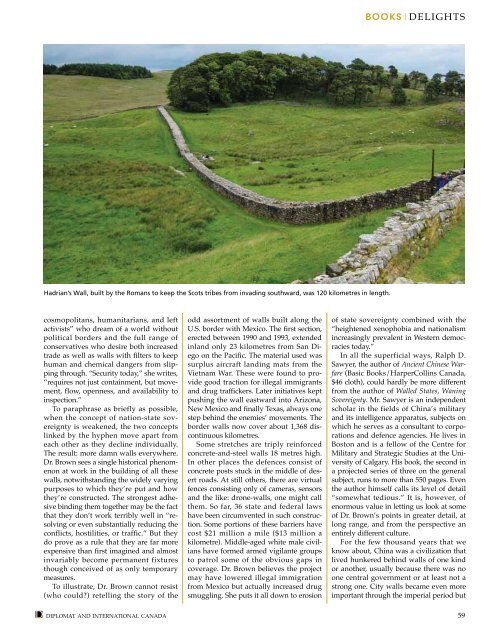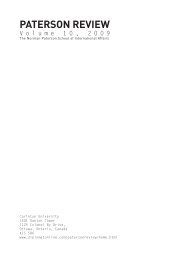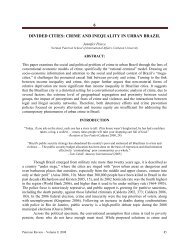the new petro power paradigm - Diplomat Magazine
the new petro power paradigm - Diplomat Magazine
the new petro power paradigm - Diplomat Magazine
You also want an ePaper? Increase the reach of your titles
YUMPU automatically turns print PDFs into web optimized ePapers that Google loves.
BOOKS|DELIGHTS<br />
Hadrian’s Wall, built by <strong>the</strong> Romans to keep <strong>the</strong> Scots tribes from invading southward, was 120 kilometres in length.<br />
cosmopolitans, humanitarians, and left<br />
activists” who dream of a world without<br />
political borders and <strong>the</strong> full range of<br />
conservatives who desire both increased<br />
trade as well as walls with filters to keep<br />
human and chemical dangers from slipping<br />
through. “Security today,” she writes,<br />
“requires not just containment, but movement,<br />
flow, openness, and availability to<br />
inspection.”<br />
To paraphrase as briefly as possible,<br />
when <strong>the</strong> concept of nation-state sovereignty<br />
is weakened, <strong>the</strong> two concepts<br />
linked by <strong>the</strong> hyphen move apart from<br />
each o<strong>the</strong>r as <strong>the</strong>y decline individually.<br />
The result: more damn walls everywhere.<br />
Dr. Brown sees a single historical phenomenon<br />
at work in <strong>the</strong> building of all <strong>the</strong>se<br />
walls, notwithstanding <strong>the</strong> widely varying<br />
purposes to which <strong>the</strong>y’re put and how<br />
<strong>the</strong>y’re constructed. The strongest adhesive<br />
binding <strong>the</strong>m toge<strong>the</strong>r may be <strong>the</strong> fact<br />
that <strong>the</strong>y don’t work terribly well in “resolving<br />
or even substantially reducing <strong>the</strong><br />
conflicts, hostilities, or traffic.” But <strong>the</strong>y<br />
do prove as a rule that <strong>the</strong>y are far more<br />
expensive than first imagined and almost<br />
invariably become permanent fixtures<br />
though conceived of as only temporary<br />
measures.<br />
To illustrate, Dr. Brown cannot resist<br />
(who could?) retelling <strong>the</strong> story of <strong>the</strong><br />
odd assortment of walls built along <strong>the</strong><br />
U.S. border with Mexico. The first section,<br />
erected between 1990 and 1993, extended<br />
inland only 23 kilometres from San Diego<br />
on <strong>the</strong> Pacific. The material used was<br />
surplus aircraft landing mats from <strong>the</strong><br />
Vietnam War. These were found to provide<br />
good traction for illegal immigrants<br />
and drug traffickers. Later initiatives kept<br />
pushing <strong>the</strong> wall eastward into Arizona,<br />
New Mexico and finally Texas, always one<br />
step behind <strong>the</strong> enemies’ movements. The<br />
border walls now cover about 1,368 discontinuous<br />
kilometres.<br />
Some stretches are triply reinforced<br />
concrete-and-steel walls 18 metres high.<br />
In o<strong>the</strong>r places <strong>the</strong> defences consist of<br />
concrete posts stuck in <strong>the</strong> middle of desert<br />
roads. At still o<strong>the</strong>rs, <strong>the</strong>re are virtual<br />
fences consisting only of cameras, sensors<br />
and <strong>the</strong> like: drone-walls, one might call<br />
<strong>the</strong>m. So far, 36 state and federal laws<br />
have been circumvented in such construction.<br />
Some portions of <strong>the</strong>se barriers have<br />
cost $21 million a mile ($13 million a<br />
kilometre). Middle-aged white male civilians<br />
have formed armed vigilante groups<br />
to patrol some of <strong>the</strong> obvious gaps in<br />
coverage. Dr. Brown believes <strong>the</strong> project<br />
may have lowered illegal immigration<br />
from Mexico but actually increased drug<br />
smuggling. She puts it all down to erosion<br />
of state sovereignty combined with <strong>the</strong><br />
“heightened xenophobia and nationalism<br />
increasingly prevalent in Western democracies<br />
today.”<br />
In all <strong>the</strong> superficial ways, Ralph D.<br />
Sawyer, <strong>the</strong> author of Ancient Chinese Warfare<br />
(Basic Books/HarperCollins Canada,<br />
$46 cloth), could hardly be more different<br />
from <strong>the</strong> author of Walled States, Waning<br />
Sovereignty. Mr. Sawyer is an independent<br />
scholar in <strong>the</strong> fields of China’s military<br />
and its intelligence apparatus, subjects on<br />
which he serves as a consultant to corporations<br />
and defence agencies. He lives in<br />
Boston and is a fellow of <strong>the</strong> Centre for<br />
Military and Strategic Studies at <strong>the</strong> University<br />
of Calgary. His book, <strong>the</strong> second in<br />
a projected series of three on <strong>the</strong> general<br />
subject, runs to more than 550 pages. Even<br />
<strong>the</strong> author himself calls its level of detail<br />
“somewhat tedious.” It is, however, of<br />
enormous value in letting us look at some<br />
of Dr. Brown’s points in greater detail, at<br />
long range, and from <strong>the</strong> perspective an<br />
entirely different culture.<br />
For <strong>the</strong> few thousand years that we<br />
know about, China was a civilization that<br />
lived hunkered behind walls of one kind<br />
or ano<strong>the</strong>r, usually because <strong>the</strong>re was no<br />
one central government or at least not a<br />
strong one. City walls became even more<br />
important through <strong>the</strong> imperial period but<br />
diplomat and international canada 59

















